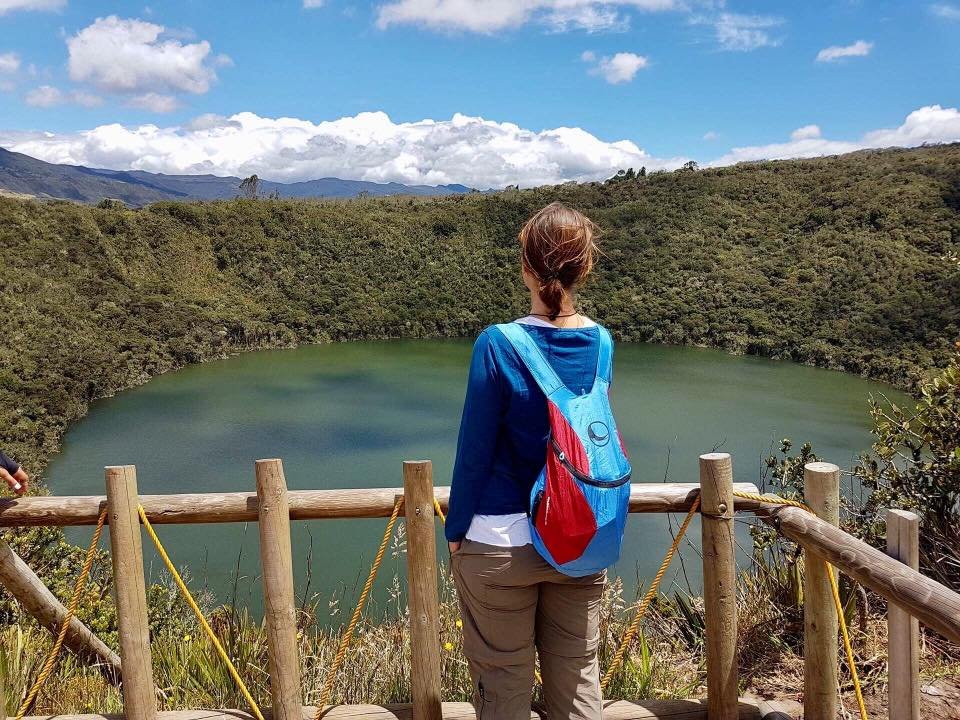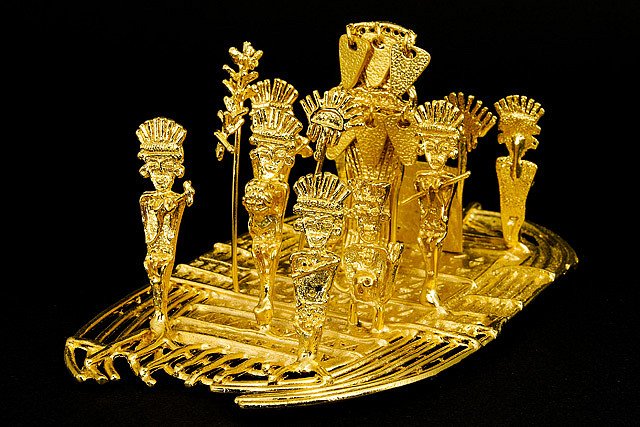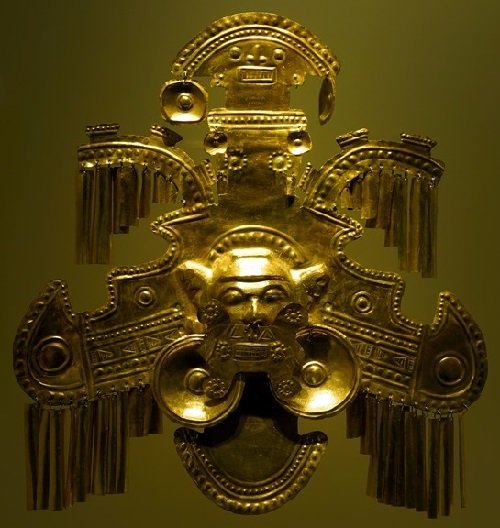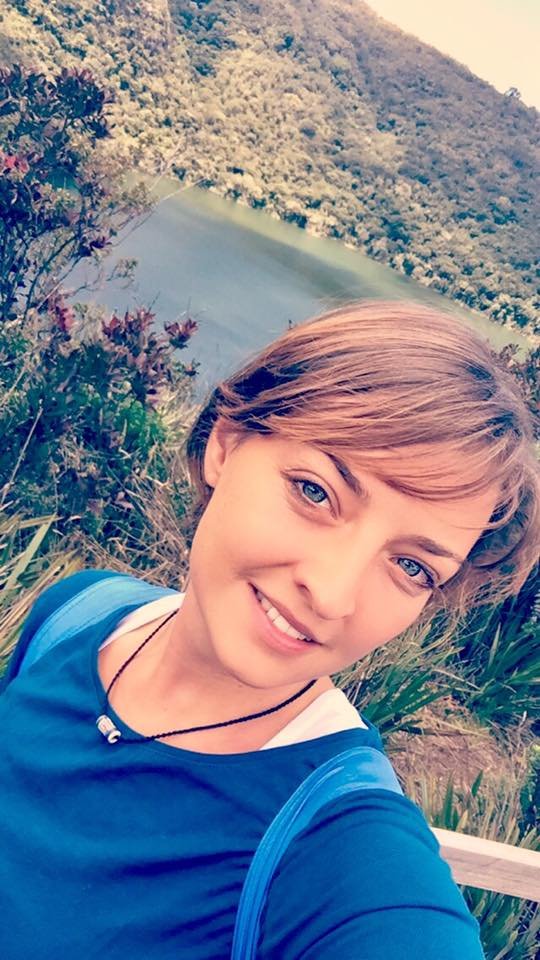The lagoon of Guatavita is a little lake in the mountains in the north of Bogota. It is located 3000m over the sea level close to Sesquilé.
Nobody knows why it´s there. There are several theories... it could have been a meteoric falling down from space or a volcanic crater, or a normal lake etc.
The laoon has a diameter of 1.6km and got famous because of the legend of "El Dorado".
So as you imagine, for us that was reason enough to take a tour there and learn more about the culture and this legend!
The earliest reference to the name El Dorado was in 1535 or 1536, before Spanish contact with the Muisca people.
When the Spanish arrived in Cartagena they where searching for gold. The indians there mentioned a city named "El Dorado", in which every house, every street and even the people are made out of gold.
That was when the big search for El Dorado began.
The following information was given to me by the leading president of the Muiscas:
Between 1531 and 1538, the German conquistadors Nikolaus Federmann and Georg von Speyer searched the Venezuelan lowlands, Colombian plateaus, Orinoco Basin and Llanos Orientales for El Dorado. Subsequently Philipp von Hutten accompanied Von Speyer on a journey (1536–38) in which they reached the headwaters of the Rio Japura, near the equator.
In 1541 Hutten led an exploring party of about 150 men, mostly horsemen, from Coro on the coast of Venezuela in search of the Golden City. After several years of wandering, harassed by the natives and weakened by hunger and fever, he crossed the Rio Bermejo, and went on with a small group of around 40 men on horseback into Los Llanos, where they engaged in battle with a large number of Omaguas and Hutten was severely wounded. He led those of his followers who survived back to Coro in 1546.
On Hutten's return, he and a traveling companion, Bartholomeus VI. Welser, were executed in El Tocuyo by the Spanish authorities.
In 1535, Captains Anasco and Ampudia were dispatched by Spanish conquistador Sebastián de Belalcázar, one of Francisco Pizarro's chief lieutenants, to discover the valley of Dorado in pursuit of the splendid riches of the Zaque, or chieftain of Cundinamarca, described by a wandering Indian of Tacumga.
In 1536 Gonzalo Díaz de Pineda had led an expedition to the lowlands to the east of Quito and had found cinnamon trees but no rich empire.
When they finally arrived to Guatavita they didn´t find a city made out of gold. The houses and environment looked more like today:

The Muisca (or Chibcha) civilization flourished in ancient Colombia between 600 and 1600 CE. Their territory encompassed what is now Bogotá and its environs and they have gained lasting fame as the origin of the El Dorado legend.
The Muisca have also left a significant artistic legacy in their superb gold work, much of it unrivalled by any other Americas culture.
Idolizing the sun, the Muisca also had a special reverence for sacred objects and places such as particular rocks, caves, rivers, and lakes. At these sites they would leave votive offerings (tunjos) as they were considered a portal to other worlds.
The most important Muisca gods were Zue the sun god and Chie the moon goddess. We also know of Chibchacum, the patron of metalworkers and merchants. The most common type of offerings to the gods was foodstuffs along with typical tunjo of snakes and flat male, female, and animal figures rendered in gold alloy which were placed at sacred sites.
Elite members of society could also be buried at such religiously significant places, first being dried and then wrapped in many layers of fine textiles, finally placed in a tomb seated on their seat of office, a small stool or tianga, and surrounded by the precious goods they had enjoyed in life.
For the Muisca, gold was though the material of choice as it was valued for its lustrous and transformational properties and its association with the sun.
It was not used as a currency, but rather as an artistic medium. Gold was mined from exposed veins and panned from mountain rivers. Gold and its alloy tumbaga (a mix of gold and copper with traces of silver) were used to make tunjos such as figures and masks, coca containers (poporos) with lime dippers, and also exquisite jewellery - typically pectorals, earrings, and nose studs
However the Muisca hat a tradition: Lake Guatavita was reputedly one of the sacred lakes of the Muisca, and a ritual conducted there is widely thought to be the basis for the legend of El Dorado, "the golden one".

Image Credit
The legend says the lake is where the Muisca celebrated a ritual in which the zipa (named "El Dorado" by the conquistadors) was covered in gold dust, then venturing out into the water on a ceremonial raft made of rushes, he dived into the waters, washing off the gold.Afterward, trinkets, jewelry, and other precious offerings were thrown into the waters by worshipers.
So as you see, they did´t have a city made out of gold, but when the Spanish heard from that ritual they where sure that they had found El Dorado.

They tried to get to the bottom of the lake to get all the gold and jewelry, so they made the Muisca digging a canal, bail the water etc.
Today you can find a few of this gold pieces at the gold museum in Bogotá.


After the president of the Muisca civilisation told us all about their history, their love to the nature and spiritual traditions we went to see the lagoon itself.
There are several view points from which you can see it and you can feel also the spiritual atmosphere standing up there!
For me it was a really interesting trip and I learned a lot about the pre colombian history!

I hope you enjoyed the read and I am greatful for every Upvote, Resteem and Follow, because you are supporting my world travel with it!
Cheers,
Liz

